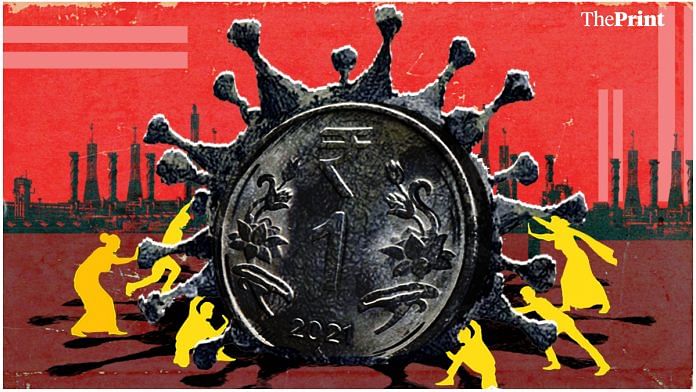A recent indicator that shows the economy is getting back on track is credit growth to large industries.
For many months, credit to the micro, small and medium enterprises sector and retail loans dominated bank loan books. But after 14 months of contraction, bank credit growth to large industries turned positive in October.
During the pandemic, on the one hand, credit had grown due to distress in both households and small firms. On the other hand, large firms had de-leveraged and seen negative credit growth. This trend appears to have changed in the latest data.
In the September quarter, India’s gross domestic product (GDP) grew at 8.4 per cent. A series of other high frequency indicators too suggest that economic recovery is gaining momentum.
However, the latest variant of Covid-19-Omicron could pose a fresh risk to the ongoing economic recovery. The uncertainties around the virus could potentially increase restrictions, thus impacting the nascent recovery visible in the contact-intensive sectors. The risk posed by the variant could delay a sustained revival in consumption spending.
Also read: Modi govt’s pandemic strategy focused on revival has worked. Economic indicators prove it
GDP growth
The latest numbers show that GDP for the July-September quarter has touched pre-Covid levels and was actually 0.3 per cent higher than the corresponding quarter of 2019-20. This is an improvement when compared to the first quarter GDP.
The April-June GDP was 9.2 per cent lower than its pre-Covid level because of the second wave of infections and consequent curbs on mobility and activity imposed by governments.
In the second quarter (July-September), with the exception of construction, trade, hotels and transport and financial services, other sectors recovered and exceeded their pre-Covid levels.
On the demand side, exports and investments were the key drivers, rising 17 per cent and 1.5 per cent over pre-pandemic levels. Consumption is yet to recover as it is still 3.5 per cent below the pre-pandemic levels.
High frequency indicators
Most high frequency indicators for October and November suggest economic revival. Manufacturing continued to perform well in October and November.
Purchasing Managers’ Index (PMI) for the manufacturing sector posted its strongest improvement in the last ten months. The headline figure was 57.6 in November, up from 55.9 in October. Encouragingly, the expansion in the manufacturing sector was supported by an accelerated rise in domestic sales.
Services activity measured by PMI Services also remained elevated in October and November, at 58.4 and 58.1, respectively.
Business confidence
Business sentiments also seem to be improving. For the September quarter, the NCAER’s Business Confidence Index increased by 90 per cent over the June quarter. The index is also higher than the pre-pandemic period.
The boost in sentiments is seen to be broad-based across large- and small-sized firms.
The Reserve Bank of India (RBI)’s Industrial Outlook Survey of the manufacturing sector also shows improvement in the overall business sentiments.
The assessment of the second quarter, measured by the business assessment index, and expectations of the next quarter, measured by the business expectations index, recorded strong improvements. Both indices have surpassed the pre-pandemic levels.
Manufacturing firms perceive improvements in production, capacity utilisation, employment and overall business situation. Fifty-two per cent of the surveyed firms expect a rise in employment in the December quarter. This is a significant jump from around 20 per cent of firms that expected such a rise in the previous round of the survey.
This is also reflected in an increase in intent to hire by companies. A recent survey indicates that Indian companies’ hiring outlook for the March quarter of 2022 is the strongest in eight years.
Also read: Economic recovery has finally begun, but India needs to watch out for global headwinds
Consumer confidence
While business sentiment in India has improved rapidly, consumer confidence is lagging. It may be some time before higher investment and business confidence impacts jobs and households and consumer confidence picks up. Currently, expenditure rise is visible through higher credit card spends.
Consumer confidence typically gets a boost when consumers perceive a sustained increase in income and employment prospects. Surveys on industrial outlook suggest that the perception and expectations on employment are improving.
With a sustained pick up in investments and hiring activity, consumer sentiments should see a boost in the coming quarters. If Omicron creates further uncertainty, the pace could be slower.
RBI’s Consumer Confidence Survey shows sentiment is still not at pre-pandemic level. The assessment of the current situation and expectations about the future, both have seen gradual gains. We expect that consumer confidence will take some time to pick up.
Omicron poses a risk to economic recovery
The emergence of the latest Covid strain, Omicron, could pose a threat to India’s near double-digit growth outlook for the current year. This risk has led many agencies to slash growth forecasts.
Fitch Ratings has cut India’s projected GDP to 8.4 per cent from 8.7 per cent for the current fiscal. The Asian Development Bank has also scaled down the growth estimate to 9.7 per cent from 10 per cent predicted earlier. For emerging Asia too, the growth forecasts have been revised downwards.
Omicron-led uncertainty is already weighing on the sentiments in the stock market. There is a possibility that our vaccines may become ineffective in emerging situations. This could slow down the revival of household consumption demand.
A surge in infections, even its possibility could trigger restrictions on people’s movements, which could dent the nascent revival seen in sectors such as travel, tourism and hospitality. If the variant turns out to be more contagious, many countries could impose fresh lockdowns. These could intensify supply side bottlenecks and logistic challenges, and affect exports.
Ila Patnaik is an economist and a professor at National Institute of Public Finance and Policy.
Radhika Pandey is a consultant at NIPFP.
Views are personal.
Also read: India needs more private insurance companies. Govt must use Covid trigger to make this happen



